Is Tamil Nadu’s Fight against COVID-19 Becoming More Challenging?
By Jafar K
Introduction
The response to the spread of COVID-19, the nature of the fight, and the survival strategies vary across regions. This is linked to their preparedness in addressing this pandemic, institutional arrangements, and support of the larger public. Compared to many other countries, India has managed to reduce the casualties to a low number but continues to experience steady growth in the number of infected people, and deaths in specific regions. The state of Tamil Nadu is known for having established an impressive public healthcare system, and health infrastructure with a large network of institutions. In response to the pandemic, the state government mobilised Rapid Response Teams (RRTs) at the state and district levels, setup control rooms, started thermal scanning of passengers, prepared isolation wards, developed guidelines and began awareness campaigns. This has directly contributed to the state’s fight against this pandemic and the strategies followed at various stages of its spread.
Changing trends of infection
In the early phase, the number of cases reported in Tamil Nadu was very low. The state reported its first confirmed case of COVID-19 on March 7, 2020, and there were only 9 cases reported till March 23, 2020. By the next week, the state witnessed a marginal but a steady increase in the corona-positive cases across the districts. But this pattern started changing from the first week of April as the number of reported cases increased to 2000 by the end of the month. During the last two weeks of April, the state experienced an alarming hike in the number of reported cases and emerged as one of the worst affected states in the country.
As per the recent update available in the Media Bulletin1 issued by the Government of Tamil Nadu on May 12, 2020, the state has 6520 active cases of COVID-19 with a total of 8718 persons tested positive (Figure 1). With 4882 confirmed cases and 39 deaths, Chennai city accounts for more than half of the total reported cases (56%) and reported deaths (64%) in the state. Across the districts, Thiruvallur, Cuddalore, Chengalpattu, Ariyalur, and Villupuram, with 467, 396, 391, 344, and 299 cases respectively, have reported the highest number of positive cases. On the other hand, Dharmapuri, Pudukottai, Sivagangai, Nilgiris, and Krishnagiri districts, with 5, 6, 12, 14, and 20 cases respectively, reported the least number of cases in the state. This pattern highlights the sharp variation which exists within the state and the specific challenges in leading the fight against this pandemic.
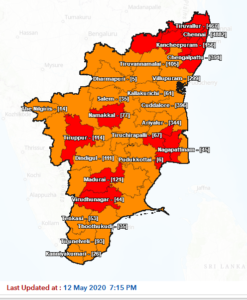 Source: TN Covid-19 Public Dashboard
Source: TN Covid-19 Public Dashboard
Figure 1: COVID-19 positive cases reported in Tamil Nadu and Chennai (till May 12, 2020)
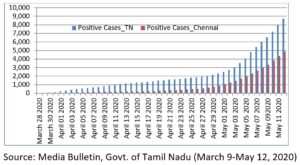
In the initial phase, the number of positive cases reported was small and concentrated in specific regions. But this pattern changed as the number of cases gradually increased, and the virus spread to other parts. The official reports appearing in mass media highlighted a sharp increase in the number of affected people after people participated in a cultural event and came in contact with others. So, while in the first two weeks of April, persons with a travel history were traced and put through screening and other processes of testing, isolation, and treatment. As of April 15, the 1113 positive cases reported in the state were connected to this cultural event (Media Bulletin, April 15, 2020). The government introduced cluster containment measures to control the transmission and potential risk associated further spread. Various measures taken by the state succeeded in controlling the spread on a larger scale as the number of new cases reported in the following days of April was moderate, with a total of 2323 positive cases reported till April 30, 2020.
Figure 2: Positive cases reported in Tamil Nadu and Chennai – Daily (till May 12, 2020)
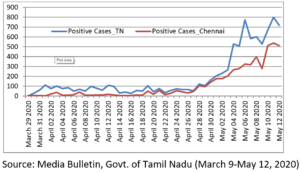
However, this pattern changed from May 1, 2020, as the number of confirmed cases started increasing at an alarming rate. During the last two weeks (April 29- May 12), Tamil Nadu reported 6660 new COVID-19 cases, i.e., 76 percent of the total confirmed cases in the state (Figure 2). During the same period, Chennai city alone reported 4205 new cases (63%). Many reports explored the sources of this pattern and identified the Koyambedu Market in the city as the new hotspot and epicentre of COVID-19 in the state. Being one of the biggest markets for vegetables, fruits, and other essential items catering to the state, as well as the neighbouring states, thousands of persons from different parts of the state and the neighbouring states, like Kerala, visited this market. Many of them got infected and emerged as carriers of the virus.
Following this, the government introduced fresh measures to control the spread, including relocating the marketplace, regulating and monitoring its functioning to supply essentials to the public. Reports indicate that 1,867 positive cases reported in the state are linked to Koyambedu Market in Chennai city (Media Bulletin, May 9, 2020). This could have led to the emergence of new hotspots and epicentres in the city areas and connected areas outside the city. Some reports indicate that a large number of newly reported cases in Kodambakkam, Teynampet, Valsaravakkam, Anna Nagar, Ambattur, and Adyar zones are traced to the Koyambedu vegetable market. And a large number of newly reported cases from Cuddalore are connected to the Koyambedu wholesale market in Chennai. These patterns indicate the emergence of new clusters of COVID-19 within and outside the city.
Table 1: Gender and Age Dimension of Reported Cases (Till May 12, 2020)
| Age Group | Males | Females | Transgender | Total |
| 0-12 Years | 261 | 226 | 0 | 487 |
| 13-60 Years | 5216 | 2416 | 3 | 7635 |
| 60 years & above | 371 | 225 | 0 | 596 |
| Total | 5848 | 2867 | 3 | 8718 |
Source: Media Bulletin, Govt. of Tamil Nadu (March 9-May 12, 2020)
The gender composition of infected people seems to follow the larger pattern reported across various countries – males account for about 67.08 percent of the total cases reported in the state. The age composition indicates that nearly 87.58 percent of the total infected persons belong to 13-60 age group of which 68. are males. At the same time, this gap is marginal for other age-groups, especially for children below 12 years (Table 1). Broadly, the number of senior persons aged 60 years and above constitutes nearly 7 percent of the total affected persons, but this group accounts for a higher share in the number of persons dead, as they are more vulnerable to the virus attack.
Figure 3: Patients discharged after treatment and number of deaths (till May 12)
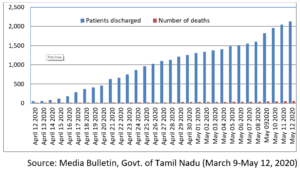
The institutional arrangements, especially the health system, responded to the situation proactively and this helped in ensuring healthcare support and treatment of the infected. This has helped in reducing the number of deaths to a minimum and led to a steady increase in the number of patients discharged after completing treatment. As on May 12, 2020, Tamil Nadu witnessed 61 deaths while 2134 patients were treated and discharged (Figure 3). Out of 61 deaths, two deaths were cross notified to other states, and one patient died after having tested negative for the infection.
Over time, there has been a steady increase in the number of active cases and the number of suspected cases admitted in isolation wards. During the last few days, the number of active cases showed a rapid growth while suspected cases marked a slow growth. The former crossed the latter on May 8, 2020, and reached a maximum of 6520 active cases against the 4401 suspected cases on May 12, 2020 (Figure 4).
Figure 4: Number of active (in treatment) and suspected (in Isolation Ward) cases
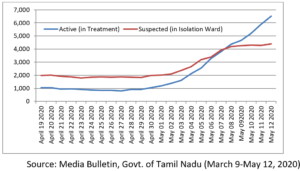
Tamil Nadu’s health system, with a well-established network of institutions, improves its preparedness and has taken the lead in the fight against this pandemic. It has developed a large number of functioning testing centres (55 as on May 12, 2020- the second highest in India after Maharashtra) across the state. This includes 38 government and 17 private testing centres.
Similarly, the state managed to mobilise support in other areas, including the availability of space required for isolation, isolation beds, and ventilators in large numbers. By April 24, 2020, the government had mobilised 29074 isolation beds and 3371 ventilators. Later, when the state witnessed a sharp increase in the number of reported cases, the state took measures to identify and prepare more spaces for isolation (including buildings of educational institutions) to manage the crisis smoothly. The state also circulated the updated list of dedicated public and private hospitals treating COVID-19 regularly. All cases were referred to these designated COVID-19 hospitals. The government also prepared detailed guidelines on treatment protocol; management of suspected cases and dead bodies; criteria for the classification of hotspots; and, protocol for use of Rapid Antibody Tests in the hotspots.
Screening, isolation and quarantine strategy
In the early stages, the state followed various measures to screen and isolate passengers at the airports of Chennai, Trichy, Madurai, and Coimbatore. A total of 210538 passengers (till April 1, 2020) were screened at these airports and sent for an appropriate quarantine process. Thus, 120362 people were put under home quarantine for 28 days, while 19 asymptomatic passengers from highly affected countries were quarantined in the quarantine facilities near the airport, and 1846 passengers were under hospital isolation on April 26, 2020 (Figure 5). This has helped in controlling the spread of the virus from persons who have travelled from the affected areas outside the state. Considering the fact that the airports were closed by the last week of March 2020, the quick process of identifying these passengers and ensuring quick quarantine measures could have reduced the chances of further transmission.
Figure 5: Passengers under Institutional Quarantine (daily)
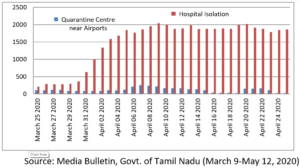
The government also followed measures to identify suspected persons and admit them in isolation wards, and others on active quarantine, if required. The number of suspected persons admitted in isolation wards increased gradually and marginally over time. The number of persons put on active quarantine at home marked a sharp reduction until the second half of April and then, started rising. Compared to this, the number of persons put in active quarantine facilities arranged by the government remains small (an average 102 persons between April 3 and May 3) and marked a minimum fluctuation (Figure 6). Thus, the strategy followed in the initial phase was focused on home quarantining.
Figure 6: Persons under active quarantine: Home and government facilities

Testing strategy
By the middle of April, there was a sharp increase in the number of total samples collected and sent for testing, and the same was facilitated by a steady expansion in the number of both public and private testing facilities developed in different parts of the state. In the recent phase, the state follows an aggressive testing strategy compared to the selective strategy it followed until the first half of April. As of May 12, 2020, the state has tested 266687 samples (from 255584 persons) at different centres. The details also indicate that a major part of the total samples tested turned out negative (96.3%) and a significant number (4.2%) was repeated samples taken from the same persons.
Figure 7: Total samples tested (till May 12, 2020)
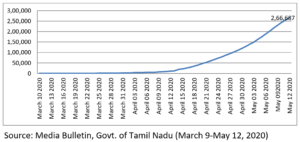
It appears that the total cases reported positive and total samples tested in the state are closely linked; both increased sharply from the second half of April. The number of samples tested, and positive cases reported daily also indicate this pattern (Figure 8). Thus, the last 10 days record the highest number of samples tested (127197, i.e., 47.7% of total samples tested) and positive cases reported (5961, i.e., 68.4% of total cases reported) till date.
Figure 8: Number of samples rested and positive cases (daily)
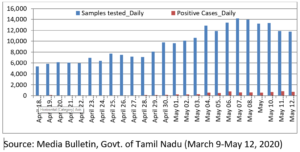
State’s response to the crisis
The state declared COVID-19 as a notified disease and formulated relevant guidelines to follow appropriate measures to prevent the spread of the disease. Following this, the government introduced ‘Tamil Nadu COVID-19 Regulations 2020’ and offered detailed guidelines about the power and responsibilities of respective agencies in controlling the pandemic. They guided the process of preparing isolation wards, containment measures in detected areas, and isolation measures for asymptomatic air travellers from highly affected countries. This was followed by a restriction in the movement of people, running of establishments, and closure of educational institutions, public places, and public transportation services. The nation-wide lockdown, which followed after the Janta Curfew, tightened this further. Amidst the lockdown, only establishments and departments engaged in providing basic services and essentials could operate. In response to the rising number of cases reported in different parts of the state, the lockdown regulations were further tightened2 with the introduction of curfew orders, and restriction on time permitted for the supply of essentials.
The state government formed various committees of officials and experts to manage the situation. An expert committee set by the state to formulate guidelines for completing the lockdown in a phased manner recommended the extension of the lockdown in the state.
The extended lockdown period, with minimal economic activities, will have an adverse impact on the state economy and on the state’s resources available to finance this fight. The government set up a High-Level Committee of economists, experts, and officials to look into the impact of COVID-19 on key sectors of Tamil Nadu’s economy and offer advice regarding the medium-term response to be followed in the state.3 On the welfare front, the state extended financial assistance and supply of essentials (through PDS) to the entitled families. The government followed some proactive measures, like special recruitment of healthcare staff (doctors, lab technicians, and nurses), to lead this fight. It also instructed district authorities to ensure the protection of the doctors and other hospital staff and follow protective measures for all the personnel serving in the containment areas.
Chennai city’s experience, with the largest share of COVID-19 confirmed cases and deaths reported in the state, highlights some unique strategies followed in the fight against this pandemic. As the number of confirmed cased started growing, the government came up with elaborate arrangements to contain and control the spread of COVID-19. To control the spread, the state instructed that all areas within a perimeter of 5 km, plus an extended 3 km suspected of an infected person’s house, have to be disinfected. All households, within the earmarked radius, were put under continuous surveillance. As per this plan, the Greater Chennai Corporation (GCC) identified the epicentres within the city and mapped a systematic plan for identifying the clusters with confirmed cases and marking the containment zones across the city. One health-worker was assigned to every fifty houses in the epicentre to monitor the health conditions of each family daily (and on alternate days in the case of buffer zones). The GCC, with the support of police and other concerned agencies, restricted the movement of people to these areas, to the minimum.
With the support of volunteers registered through a special drive, the government ensured strict isolation in the containment areas in the city. Persons living in containment areas were not allowed to come out or let outsiders come in contact them. Volunteers helped persons living in containment areas in accessing essential and basic services. Depending on the risk factor, the government reorganised the timings for the opening of shops supplying essential items. When the number of cases increased sharply, the GCC launched mobile markets to sell vegetables and groceries at the doorsteps of the residents to restrict their movement and prevent crowds from gathering in the markets. With the support of the Tamil Nadu Traders Association, the GCC announced the launch of 7,000 mobile outlets to vend groceries and vegetables in the city through 5,000 tricycles and 2,000 light cargo trucks. Online food delivery companies, such as Zomato and Swiggy, also started delivering fruits, vegetables, and other essential items at the doorsteps. Through its official channels, press releases, and social media, the GCC circulated the latest updates on the situation and the guidelines to be followed in general, and in containment areas.
Following the lockdown, most of the food outlets remain closed (except for a few restaurants which continued parcel services during specific times). By keeping its Amma Canteens (‘Amma Unavagam’ – subsidised food outlets) open, the state could feed thousands of poor living in urban areas and address the shortage of food. Recently, the GCC has started serving free food through over 400 Amma Canteens in Chennai and announced that it will serve free food to people at all its eateries till the nationwide lockdown ends. During the lockdown, this has turned out to be the saviour for all sections, including migrant workers, truck drivers, street dwellers, workers engaged as security staff, delivery boys, and other groups living in the city. This was equally supported by the relief activities undertaken, especially through the distribution of cooked food and essential items like groceries, vegetables, etc. initiated by various organisations.
Following the national lockdown guidelines, the state came up with some unique strategies. This includes efforts to ensure the supply of essential items and services, identification of clusters with higher risk, and mobilising additional human resources and volunteers to support this drive. There has been some effort in extending healthcare, supplying essentials, and other forms of social protection to the vulnerable sections like migrant workers and casual labourers. For instance, there was an effort to quarantine migrant workers and conducting health camps. Better coordination of different agencies could address the concerns that came up in this regard.
Challenges ahead
For Tamil Nadu, the first concern is around the alarming growth in the number of positive cases reported in recent days. The strategy followed and executed in controlling the transmission could be revisited. Unlike the earlier phase where cases were connected to people with foreign travel history, the current trend is triggered by contact in specific hotspots. The fact that the majority of the recent cases reported in the state are through contacts with infected people, and it is difficult to trace the sources of infection, indicates the possibilities of community transmission and a potential crisis. A steady increase in casualties and a moderate rate of recovery (as compared to the new cases reported) also raises concern on the emerging trend.
Some reported cases highlight the importance of tightening the screening, isolating, tracing of contacts, and testing processes in the early phase. This could have helped in identifying the hotspots and taking effective measures for containment and regulating contact. There are concerns about the shortage of protective gear for securing the lives of people leading the fight against this pandemic. The spread of positive cases among people engaged in providing basic services and supplying essentials, like health-care workers, police, media persons, essential suppliers including the mobile vendors, sanitary workers, persons working in Amma Canteens and other groups, indicate the nature of the crisis.
There exists a general feeling that the government should take more responsibility in terms of arranging more institutional quarantine facilities and discourage home quarantine except in unavoidable situations. The state could have been more prepared with announcing the extended lockdown and further tightening of it within the period. For instance, the special lockdown announced by end of the second phase of the national lockdown (introduction of a curfew in major cities) led to severe pressure on the people and led to panic buying of essentials and other items. Koyambedu’s emergence as the largest hotspot in the state could also be due to this as it brought thousands of people into the markets, leading to a violation of the guidelines already existing during the nation-wide lockdown. A phase-wise introduction of extension or relaxation of the lockdown rules will help the public and key actors to prepare themselves better.
Tamil Nadu also faces some other general issues – nature of the virus (life-span), variation in symptoms recorded across regions, possibilities of ‘super carriers’ (people without symptoms as carriers), and delays in developing proper vaccination indicate many challenges at the public health front. Other issues like a shortage of essentials, personal protective items (for persons engaged in delivering basic services and the larger public), stranded people (migrants, visitors, students, etc.), loss of livelihoods, and violation of lockdown rules also make this fight more challenging.
Concluding remarks
The differences in local contexts and the availability of effective treatment affect the way each region takes this fight forward. Along with the existing systems and networks of medical infrastructure, specialised branches like public health and epidemiology, make critical contributions in this fight. Tamil Nadu has an impressive record of public healthcare and establishing one of the best networks of health institutions in the country. Developing specialised centres focusing on new epidemic outbreaks and public healthcare challenges would supplement and make its fight against COVID-19 more effective.
In the next phase, revisiting its strategy could resolve some of these concerns and control this pandemic effectively. Various measures can supplement the state’s aggressive testing strategy. For instance, ensuring the availability of protective/security gear for people providing basic services, like healthcare, police, media, essential suppliers, and the general public has to be considered as a priority. Identifying, managing the hotspots and epicentres at the early phase; and, managing the containment zones, especially in cities, are crucial in controlling its spread and potential casualties. Similarly, the extension and relaxation of lockdown, restoration of public transportation (especially long-distance and inter-state) are likely to put further pressure on the existing arrangements, and therefore, these interventions have to be made with care and preparedness. As the number of positive cases continues growing at an alarming rate, Tamil Nadu’s Chief Minister urged the Prime Minister not to allow regular air and rail services into the state till May 31 and to extend the lockdown to the next phase. Given its record in public healthcare and welfare regimes, the state may manage this crisis and may soon move on to the new normal.
AUTHOR
Jafar K, PhD, Assistant Professor, Madras Institute of Development Studies, Chennai
Disclaimer: The views and opinions expressed in this article are those of the author/s and do not necessarily reflect the official policy or position of Azim Premji University or Foundation.

